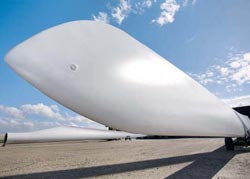Wind Turbine Blade Inspection Using Dantec Dynamics Shearography Systems

Windmillblade<br>
Complex structures
Wind turbine blades are highly sophisticated products, composed of a variety of materials and composites. They are safety relevant components and, therefore, 100% quality control has to be assured. Each turbine blade is manufactured as a composite, with wood forming the core of the blade, covered with one or more layers of glass fibre plastics on the outside. Various design features strengthen the structure of the blade so that blade lengths of more than 50 metres can be achieved. The high demand on larger and highly efficient blades leads to a high-tech product where weight and quality is the key to success.
100%-inspection requierd
The production of these turbine blades follows a rather complicated and complex procedure and, consequently, nearly 100% inspection of the blades is required after production. The new Shearography Sensor Q-800 combined with the user friendly ISTRA 4D Software is used to define the parameters for an upcoming fully automatic inspection system.
The huge dimensions of the blades require a fast and reliable inspection technology which can cover several square metres in a very short time.
Furthermore, the shape of the blade requires a non-contact and full field measurement system. The varying curvatures and surface conditions must be covered by the system without any modification.
The increase in production rate causes a higher risk of production variations which must be recognised by such a new technology. The shearography system can detect these variations and can display defects, such as wrinkles, delaminations, debondings and kissing bondings.
Excitation of turbine blade
The excitation technique will be determined during the initial test phase by the R&D department. The thermal excitation has already proven to successfully detect wrinkles in highly stressed areas of the blade. The verification of the vacuum loading will also be a part of the evaluation process where the most practical method will be determined.
Shearography sensor
The laser Shearography sensor Q-800 consists of two (2) Diode lasers mounted to the sensor housing. The sensor is connected to a controller which is linked to the evaluation PC. The complete system set-up takes less than 5 minutes to be ready for the first measurement. The sensor allows a variable field of view by positioning it at different distances from the object surface.
This provides maximum flexibility to the operator and the best set-up in relation to the detectable defects can be easily verified. This principle is used to provide parameters for the design of the automatic inspection system.
Laser illumination
The inspection areas are illuminated by the red light of two Diode lasers mounted on the sensor head. They provide sufficient light to illuminate an area of 200 x 300 mm which already allows for a faster inspection than current technologies can provide.
Easy and fast operation
The complete system is operated by the user friendly Dantec Dynamics software ISTRA 4D. The software offers full control of all measurement specific tools including camera gain, shear angle adjustment, image evaluation parameters, defect sizing, calibration of the field of view, Realtime Phase Image Display and automatic image storing.
Outlook to the automatic system
The goal of the pre-evaluation in the R&D department is to define the best practice and the parameters for the production unit. This unit has to be fully automatic to cover the high production rate of the blades. The unit will use a gantry system to move the sensor system from one inspection area to the other. The gantry as well as the operation of the shearography system will be controlled by a single software platform which can be a steep learning curve during the training. Therefore, positioning of the sensor, image acquisition and evaluation will be done automatically based on the pre-defined parameters. The software will allow for automatic defect detection and any potential deviation is automatically registered in the report. The final operator review will offer a re-test of specific areas, acceptance of the deviation or rejection of the blade. An automatic test report is included so operator input is kept to minimum.
Defect display
The results of the measurement are displayed in Realtime to the operator which displays a continuous view of the surface response due to the excitation. The operator can easily detect any variation or anomaly in the field of view and with one ‘click’, all images are stored automatically. These images can be later reviewed in a repository where the best image is selected to be used for e.g. reporting. The image below shows an example how these images are displayed to the operator.
Conclusion
In comparison to existing inspection technologies, Shearography has proven to be faster, easier to operate and capable of ensuring the high quality of the production turbine blades required, even under higher production rates and shorter inspection cycles.
For more information please contact:
Dantec Dynamics GmbH
Kaessbohrerstrasse 18
89077 Ulm
Germany
Tel.: +49-731-933-2200
Fax: +49-731-933-2299
E-mail: product.support@dantecdynamics.com
Dantec Dynamics undertakes a continuous and intensive product development programme to ensure that its instruments perform to the highest technical standards. As a result the specifications in this document are subject to change without notice.
Media Contact
More Information:
http://www.dantecdynamics.comAll latest news from the category: Corporate News
Newest articles

NASA: Mystery of life’s handedness deepens
The mystery of why life uses molecules with specific orientations has deepened with a NASA-funded discovery that RNA — a key molecule thought to have potentially held the instructions for…

What are the effects of historic lithium mining on water quality?
Study reveals low levels of common contaminants but high levels of other elements in waters associated with an abandoned lithium mine. Lithium ore and mining waste from a historic lithium…

Quantum-inspired design boosts efficiency of heat-to-electricity conversion
Rice engineers take unconventional route to improving thermophotovoltaic systems. Researchers at Rice University have found a new way to improve a key element of thermophotovoltaic (TPV) systems, which convert heat…



